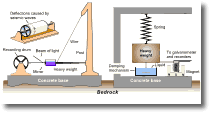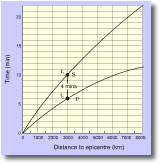Locating
Earthquakes
Figure
3
 P-waves
travel faster than S-waves and arrive at a seismograph first (Figs
3 & 4). The difference in arrival times between P-waves and
S-waves is a direct measure of the distance of the earthquake epicentre
from the seismograph. A seismograph consists of a seismometer, which
senses the motion of the ground, and a recorder. Seismic patterns
are usually recorded on paper seismogram attached to a revolving
drum (as shown here) and this paper has to be changed daily. Modern
seismometers are directly linked to a computer and record the data
in digital form. P-waves
travel faster than S-waves and arrive at a seismograph first (Figs
3 & 4). The difference in arrival times between P-waves and
S-waves is a direct measure of the distance of the earthquake epicentre
from the seismograph. A seismograph consists of a seismometer, which
senses the motion of the ground, and a recorder. Seismic patterns
are usually recorded on paper seismogram attached to a revolving
drum (as shown here) and this paper has to be changed daily. Modern
seismometers are directly linked to a computer and record the data
in digital form.
Figure
4
 Figure
4 shows a plot of P-wave, and S-wave arrival times against distance
to the epicentre, based on numerous records worldwide. For individual
seismograms the difference in arrival time between P-waves and S-waves
is measured, and the corresponding difference in time (parallel
to the y-axis or vertical axis) is found between the curves labelled
S and P. Figure
4 shows a plot of P-wave, and S-wave arrival times against distance
to the epicentre, based on numerous records worldwide. For individual
seismograms the difference in arrival time between P-waves and S-waves
is measured, and the corresponding difference in time (parallel
to the y-axis or vertical axis) is found between the curves labelled
S and P.
The distance can then be read off the x-axis or horizontal axis.
For example, a difference of 4 minutes between P and S arrival times
is plotted as t1 and t2, respectively, in Fig 4. This corresponds
to a distance of 3000km.
Figure
5
 Once
distance from the station is calculated it is plotted as a circle
around the station with a radius equal to the calculated distance.
It soon becomes apparent that a minimum of three stations is required
to locate the epicentre (Fig 5). Once
distance from the station is calculated it is plotted as a circle
around the station with a radius equal to the calculated distance.
It soon becomes apparent that a minimum of three stations is required
to locate the epicentre (Fig 5).
In
practice the differing layers in the earth's crust, in which seismic
waves travel at different rates, lead to some variance in travel
times as does the depth-to-focus. The precise calculations are usually
done by computer.
|



